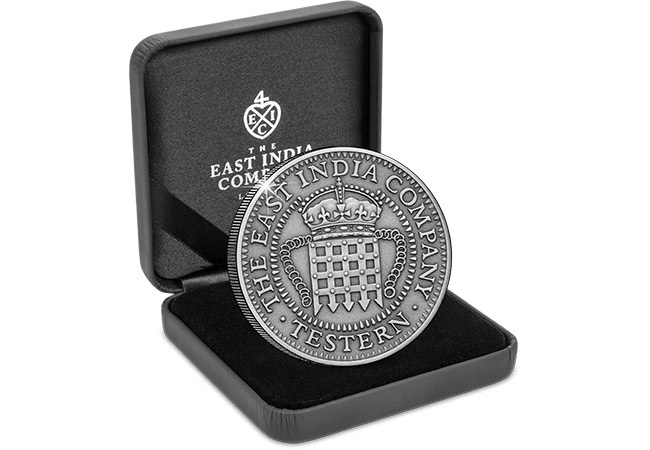Posts Tagged ‘Numismatic’
The Secret Life of Isaac Newton…
English mathematician, astronomer, and physicist, Sir Isaac Newton is one of the most famous scientists of all time. He is renowned for producing the single most influential book on physics ever written, The Philosophiae Naturalis Principia Mathematica, but not many people know that discovering why apples fell from trees and changing the way we understand the universe were not the only problems he dealt with…
Newton and the Counterfeiter

The Tower of London – Home of The Royal Mint for 500 years. From 1279 – 1812.
In 1695, The Royal Mint discovered that a large number of the UK’s circulating coins were fake. In fact, 10% of England’s coinage was known to be phony. Unable to keep up with the increasing intelligent counterfeiting methods they turned to England’s ‘brightest mind’ for help.
Sir Isaac Newton was appointed warden of The Royal Mint, with a sole purpose of enforcing laws against counterfeiting.
Most counterfeits were easy targets for Newton, but one man in particular kept eluding his grasp – William Chaloner.
Chaloner was a nail maker by trade but found a more worthwhile application for molten metals. The counterfeiter’s self-made wealth enabled him to pose in a way that matched his intellect.
Newton wanted nothing more than to finish Chaloner. He went into full detective-mode.
Newton undercover

Sir Isaac Newton
Newton constructed a strong case, using his network of informants and spies around London in a systematic way to form a complete representation of Chaloner’s actions. He even went undercover himself to obtain evidence from witnesses at pubs around the city. By the time the trial came, he had gathered eight witnesses.
The treason charge stuck – on March 3rd 1699, William Chaloner was sentenced to hang.
Later that year, Newton was made the Master of the Mint, a position he would hold until his death in 1727.
Master of the Mint
Newton took up his duties with effect from Christmas Day 1699. Immediately his active involvement in the affairs of The Royal Mint became undoubtable, he took the role very seriously before retiring from his duties at Cambridge in 1701.
He survived the political upheavals of those distressing times and in 1705 he was knighted by Queen Anne, making him just the second scientist ever to be knighted.
The first gold standard
During his role as Master of the Mint, Sir Isaac Newton wrote a report to the Lords Commissioners of His Majesty’s Treasury, as a result the relationship between gold and silver coins was forever changed by Royal proclamation at the end of 1717. It forbid the exchange of gold Guineas for more than 21 silver shillings. This meant that silver coins were being used to pay for imports, subsequently Britain saw a silver shortage – effectively moving the country from the silver standard to its first gold standard.
His Legacy to our coinage

The UK Sir Isaac Newton 50p
As a result of Newton’s vision, coins struck by The Royal Mint remain unrivalled in their accuracy and purity. He helped to make Britain’s currency one of the most respected and admired in the world. As one of the most famous figures to ever hold the role of Master of the Mint and author of the single most influential book on physics ever written it is entirely appropriate he is celebrated on a UK coin.
If you’re interested…
A brand new UK 50p coin has just been issued by The Royal Mint to commemorate the 375th anniversary of Sir Isaac Newton’s birth and his outstanding legacy.
You can own one today.
The story behind England’s first colonial coinage…
The story behind England’s first colonial coinage is one that few people know about. It begins with the most influential company in world history – The East India Company…
The East India Company today are producers and distributors of quality, exclusive and exotic goods with a 400 year legacy through its trade history, which built the British Empire.
Originally, the East India Company was a band of pioneering merchants who were granted a Royal Charter by Elizabeth I in 1600 to explore the East Indies and bring back exotic goods to the Regal West. In doing so they established new trade routes and broke down the barriers of the world. They established Singapore and Hong Kong, held Napoleon captive in St. Helena and sent the tea that was destroyed at the Boston Tea Party.
The consequences of the Company’s actions are the very fabric of our Commonwealth.
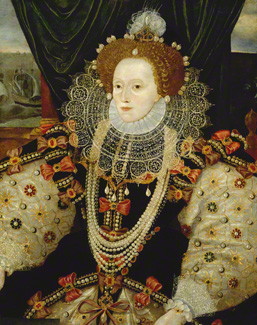
Queen Elizabeth I
England’s very first colonial coinage – struck for the company’s first voyage
In 1601, Queen Elizabeth I signed a Royal Charter awarding The East India Company the right to monopoly on trade in the East.
On signing the Royal Charter, Queen Elizabeth I instructed The Royal Mint to strike England’s very first colonial coinage – the Testern coin. Struck specifically for The Company’s first voyage to the East, the Testern was the very first currency that was minted specifically for trade outside of England.
Following the defeat of Spain in the Spanish Armada in 1588 and after the death of Prince Philip of Spain, the British colonial era of empire commenced and the start of 270 years of trade and conquest began.

The Originial Testern Coin
It’s believed that Queen Elizabeth I insisted on her own trade coinage as means of demonstrating that she was just as powerful as the King of Spain, which would only be effective if it was based on the prevailing international trade coin of the time – the Spanish Real. So, she introduced a coin that was minted in the exact same specification as the Spanish 8 Real denomination, commonly known as ‘Pieces of Eight’. This coin was formally named the Testern but came to be known as ‘Portcullis Money’ due to its unique Portcullis design.
The end of the Testern
Elizabeth I insisted that The East India Company carried the new Testern coins on each voyage, as means of exhibiting her power overseas. Just over £6,000 worth of ‘Portcullis Money’ was loaded onto the vessels of Sir James Lancaster VI’s fleet – the first fleet of The Company. When the fleet arrived in the East many of the coins were melted down, and very few returned to England. In fact, those that did were presented to The Company’s shareholders.
A coin found only in museums

The 2017 Silver Testern Coin
Today, you will only find these coins in museums and even then only a very small number of the Testern ‘Portcullis Money’ coins will be exhibited across the world.
This year, The East India Company and St Helena government have issued the Testern coin in Silver featuring a design based on the original ‘Portcullis money’ and struck in the same weight specification as the Testern coins. Only the second ever minting of Portcullis Money, the design features the iconic portcullis engraving just as its 1601 predecessor.
If you’re interested…
Fully approved by Her Majesty Queen Elizabeth II and strictly limited to just 10,000 coins worldwide, you can own the 2017 Testern Silver coin today if you’re quick.
Released today: the new 2017 United Kingdom Prince Philip £5 coin
On 4th May Buckingham Palace announced that HRH the Duke of Edinburgh, after 70 years at Her Majesty’s side, would be retiring from public duty. To mark this record-breaking achievement, and celebrate his 70 years of service to Her Majesty the Queen, The Royal Mint have today released a brand new design in tribute to Prince Philip.
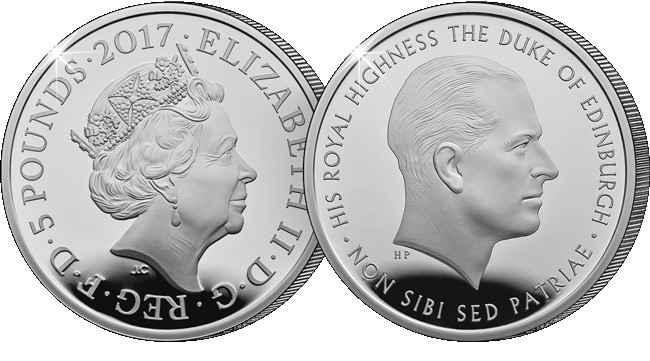
The design features Humphrey Paget’s (1893-1974) portrait of The Duke of Edinburgh. Paget’s legacy was much more than just this portrait though – he is now considered to be one of the most exceptional coin artists of the 20th century.
The Royal Mint’s coin designer Lee R. Jones has added to the portrait to include a table inscription and an edge inscription. The final design has been officially approved by Prince Philip himself.
The coin is available in Gold Proof, Silver and Brilliant Uncirculated Base Metal. Here’s your guide to the new 2017 United Kingdom Prince Philip £5 coin range:
Perfect Quality. Very Affordable.
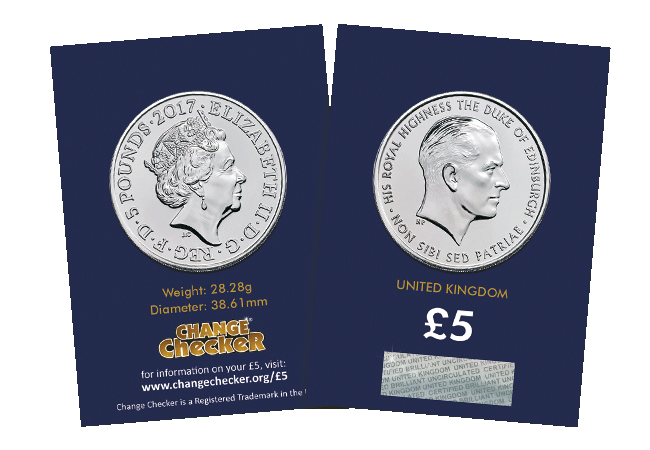
The Prince Philip CERTIFIED BU £5 Coin
The Royal Mint is releasing a brilliant uncirculated base metal version of the Prince Philip £5 coin. These coins have been specially struck and carefully handled to ensure that they are free of scratches and chips found amongst circulating coins.
Known as Brilliant Uncirculated (BU), they are available for £13.00 in a Royal Mint Presentation Pack or £10.99 in a Change Checker Certified Brilliant Uncirculated Collector Card.
Silver Proof – the Collector’s Favourite.
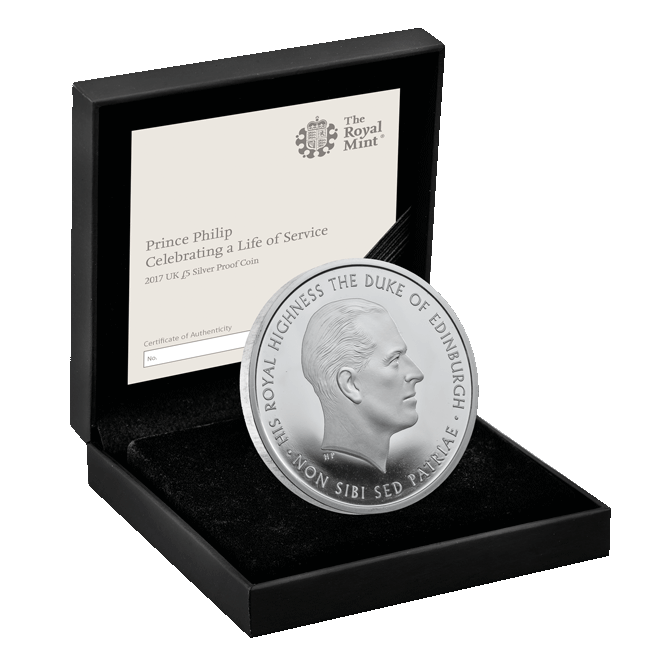
UK 2017 Prince Philip Silver Proof £5
The Silver Proof £5 coin is firmly established as the most sought-after coin amongst collectors because they have all the qualities that collectors really desire.
- Precious metal content – struck from 925/1000 Sterling Silver
- Strictly Limited Edition – just 3,000 coins. That’s EVEN LESS than the last UK Prince Philip coin issued for his 90th birthday. With a mintage of 4,599 it was, at the time, the most limited Silver Proof UK £5 coin ever issued.
- The perfect Proof Finish – even better than Brilliant Uncirulated. Proof coins are struck several times using specially polished dies to create a flawless finish with a perfect mirrored background. The ultimate coin quality.
The Gold Standard
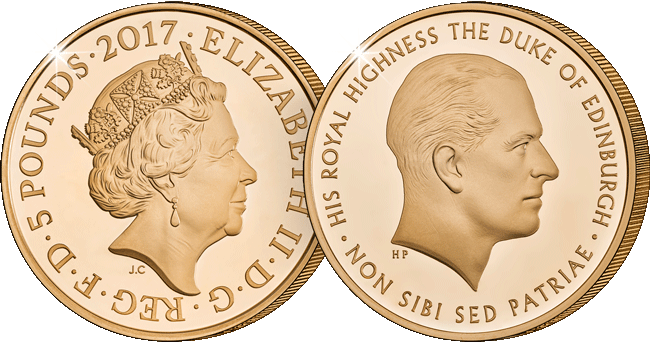
UK 2017 Prince Philip Gold Proof £5
For the ultimate limited edition, a Gold Proof coin has also been issued. Struck in 22 carat Gold, just 300 of these coins have been authorised for release.
If you’re interested …
You can own one of the Prince Philip £5 Coins. Click here to see the range >>


